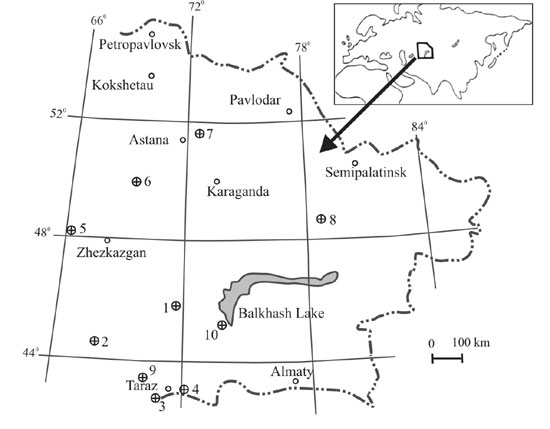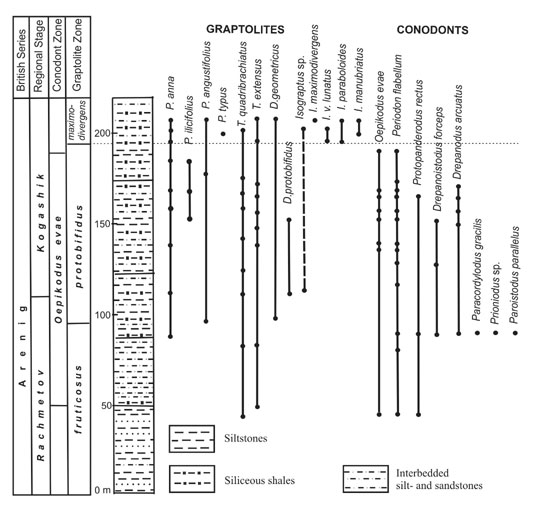
The Lower–Middle Ordovician boundary in Kazakhstan
Igor F. Nikitin1, Tatjana N. Koren’2 , Olga I. Nikitina1, Leonid E. Popov3 and A. M. Zhilkaidarov4
1 K.I. Satpaev Geological Institute, Almaty, Kazakhstan Republic.
2 A.P. Karpinskii All–Russian Geological Research Institute, Sredny 74, 199106 St. Petersburg, Russia. E–mail: koren@vsegei.sp.ru
3 Department of Geology, National Museum and Galleries of Wales, Cardiff, Wales, UK
4 Committee for Geology and Protection of Mineral Resources, Kokshetau, Kazakhstan Republic.
Key words: Graptolites. Conodonts. Stratotype. Lower–Middle Ordovician. Kazakhstan.
Introduction
The purpose of this paper is to discuss the correlation potential of graptolite and conodont species important for marking the boundary between Lower and Middle Ordovician Series in Kazakhstan.
The deep–water, hemipelagic and pelagic deposits of Arenig age representing slope and basin environments are widespread in Kazakhstan. Condensed and often continuous successions of sandstones, carbonates, siliceous shales and cherts yielding graptolites and conodonts are known in the Karatau Mountains, the northern part of Betpak–Dala (Figure 1, 1), the Sarysu–Teniz watershed (Figure 1, 6) and in the Chingiz Range (Figure 1, 8). Continuous, shallow–water successions composed of sandstones, mudstones and limestones yielding shelly fauna are known only in Maly Karatau (Figure 1, 9) and in north–western part of the Balkhash Lake area (Apollonov et al., 1990; Dubinina, 2000).
Data on graptolite– and conodont–bearing localities
The complete section of the Kushek Formation, 260 km to the north of Taraz City in Northern Betpak–Dala (Figure 1, 1), is the most important for the problem under discussion, because it is the only locality in Kazakhstan, where I. v. lunatus Harris was found. It is a well known section exposed along a row of hills called the Golybaya Gryada (Blue Ridge) first described by Keller (Keller and Lysogor, 1954; Nikitin, 1972, Nikitin et al., 1980; Dubinina et al., 1996). The Kushek Formation is a continuous succession with the following graptolite zones: Tetragraptus approximatus, Pendeograptus fruticosus, Didymograptud protobifidus, Isograptus maximodivergens, D. (Expansograptus) hirundo and Paraglossograptus tentaculatus. The I. maximodivergens Zone was traditionally recognized in Kazakhstan above the D. protobifidus Zone (Tsai, 1988, 1995, Dubinina et al., 1996). The unit was described as an assemblage zone and the lower boundary was defined by the appearance of numerous isograptids at the Golubaya Gryada section as it is shown on Figure 2. Here, the FADs of I. v. lunatus Harris and I. paraboloides Tzaj are followed by the appearance of Isograptus manubriatus (T.S. Hall) and I. maximodivegens Harris. The last occurrences of Ph. ilicifolius (J. Hall) and other phyllograptids of a broader stratigraphic range and the layer with the first finds of I. v. lunatus are separated by siliceous beds bearing conodonts of the Oepikodus evae Zone (Figure 2). This allows presuming that the lowermost occurrence of I. v. lunatus in this particular section is at least close to the FAD of the species known elsewhere.

Figure 1. Schematic map showing the location of the sections of the Lower–Middle Ordovician boundary beds in Kazakhstan: 1, North Betpak–Dala; 2, North–Western Karatau (Suyndyk River); 3, South–Eastern Kara–Tau and the Dzhabagly Mountains; 4, western margin of the Kirgyz Range; 5, Baikonur River; 6, Sarysu –Teniz Watershed; 7, upper part of the Selety River (Akzhar River), 8, Chingiz Range (Ushkyzyl Hills); 9, Malyi Karatau; 10, Southwestern part of Balkhash area (Burubajtal section).
The graptolite–bearing beds are assigned to the I. maximodivergens Zone, which falls within the Kogashik Regional Stage (Nikitin, 1991; Tsai, 1979, 1995). The I. maximodivergens and D. (E.) hirundo Zones were also recognized in outcrops of the same formation along the Zhaksykon River in the Sarysu –Teniz watershed. The I. maximodivergens Zone contains Tetragraptus bigsbyi (J. Hall), T. quadribrachiatus (J. Hall), Phyllograptus anna (J. Hall), Pseudotrigonograptus ensiformis (J. Hall), Expansograptus extensus (J. Hall), Corymbograptus deflexus (Elles and Wood), Isograptus gibberulus (Nicholson), I. maximodivergens Harris and Pseudisograptus manubriatus (T. S. Hall).The graptolite–bearing Arenig strata assigned to the Kamal Formation can be traced for more than 500 km from the Bolshoj Karatau on the north–west (Figure 1.2) to the Dzhabagly Mountains (Figure 1.3) to the south–east. The most complete section of the formation occurs in the Suundyk River basin of the northwestern Karatau (Figure 1, 2). Here, an identical succession of mid–Arenig graptolite assemblages of the D. protobifidus, I. maximodivergens and D. (E.) hirundo zones was differentiated by Tsai (1995). The assemblage of the I. maximodivergens Zone includes Dichograptus maccoyi Harris and Thomas, Tetragraptus bigsbyi (J. Hall), Phyllograptus anna (J. Hall), Pseudotrigonograptus ensiformis (J. Hall), Expansograptus extensus (J. Hall), Isograptus maximodivergens Harris and I. elegans Tzaj. I. v. lunatus was not found here.
A more diversified graptolite assemblage of the I. maximodivergens Zone was identified in the terrigenous, flysch–like beds of the Zoriev Formation in the Selety composite synclinal structure (Figure 1, 7). The zone includes Loganograptus logani (J. Hall), Tetragraptus bigsbyi (J. Hall), T. bigsbyi latus Hsü, Phyllograptus anna (J. Hall), Ph. densus opulentus Monsen, Pseudotrigonograptus ensiformis (J. Hall), Expansograptus pennatulus (J. Hall), E. similis (J. Hall), Corymbograptus deflexus (Elles and Wood), Isograptus gibberulus (Nicholson), I. forcipiformis latus (Ruedemann), I. elegans Tzaj, I. hemicyclus Harris, I. imitata (Harris), I. maximodivergens Harris, I. paraboloides Tzaj, I. shrenki Obut and Sobolevskaya, I. walcottorum Ruedemann, Pseudisograptus dumosus (Harris) and P. manubriatus (T.S. Hall). However, owing to the complicate tectonic structure relationships with the underlying and overlying graptolite successions are difficult to recognize.

Figure 2. The lithological log with the occurrences of the key graptolite and conodont taxa in the Kushek Formation of the Golubaya Gryada section, situated in 300 km to the north of the Taraz City in Betpak–Dala (Dubinina et al., 1996, modified).
Well exposed and easily accessible section of the Kyzylkajnar Formation of Arenig–Llanvirn age in the Kirgyz Range, 80 km east of Taraz City (Figure 1, 4), is of importance to the problem. The lower part of formation is represented by grey–greenish, unfossiliferous flysch deposits, and the middle part of black shales and siltstones yielding many graptolites. The graptolites are Acrograptus dilatans (T.S. Hall), A. gracilis (Törnquist), Tetragraptus bigsbyi (J. Hall), T. serra Brongniart, Phyllograptus anna (J. Hall), Pseudophyllograptus. angustifolius (J. Hall), Pseudotrigonograptus ensiformis (J. Hall), Expansograptus decens (Törnquist), E. ex gr. suecicus (Tullberg), E. robustus (Ekström), Corymbograptus aff. V–fragosus Obut and Sobolevskya, Isograptus gibberulus (Nicholson), I. maximodivergens (Harris), I. shrenki Obut et Sobolevskaya, I. walcottorum Ruedemann, I. furcula Ruedemann, I. victoria (Harris), I. divergens (Harris), I. maxima (Harris) and others forms characteristic of the I. maximodivergens and D.(E.) hirundo zones [Zima, 1976]. This section and its graptolite content have to be fully studied.
Data on conodont–bearing localities
The bedded cherts yielding many radiolarians, conodonts and rare lingulid brachiopods represent another type of deep–water facies development in the Upper Cambrian and the Lower–Middle Ordovician successions of Kazakhstan. They occur through central Kazakhstan, including the Predchingiz area (Nikitin, 2000). Normally these strata are strongly deformed and segments of continuous successions are difficult to recognize. One segment is represented by the section of the Ushkyzyl Formation of Arenig–Llanvirn age in the southwestern Predchingiz area (Nikitin et al., 1992). Here, Zhilkajdarov recognized a conodont assemblage succession. The stratigraphically lowest Prioniodus elegans zonal association includes the index – species associated with Acodus deltatus (Lindström), Paroistodus proteus (Lindström), Paracordylodus gracilis Lindström, Protoprioniodus papiliosus (van Wamel) and Drepanodus arcuatus Pander. The recognition of the O. evae Zone is based on the occurrences of P. gracilis Lindström, P. flabellum (Lindström), P. proteus (Lindström), P. elegans Pander and O. evae (Lindström). This assemblage is similar to the one discovered in the Golubaja Griada (Figure 1, 1; 2) and Burubajtal section of the southwestern part of the Balkhash Lake area (Figure 1, 10; Tolmacheva et al., submitted) and it is also known in the Billingen Regional Stage of Baltoscandia. However, the only finds of Tripodus cf. T. laevis (Bradshaw) has been documented above the O. evae Zone from the middle part of the Burubajtal Formation.
The upper part of the Ushkyzyl Formation yields an assemblage containing P. flabellum (Lindström), Baltoniodus navis Lindström and Paroistodus originalis (Sergeeva), which is typical of B. navis and P. originalis zones of the Volkhov Regional Stage of Baltoscandia (Löfgren, 1978; 1995). The same conodont zones were recognized in the Kosgombaj Formation cropping out in a series of tectonic slices in the Maykain–Kyzyltass ophiolite belt of the northeastern part of Central Kazakhstan (Nikitin, 2002).
Conclusions
The complete section at Golubaia Gryada spanning the Lower–Middle Ordovician boundary beds is represented by interbedded shales and cherts with diagnostic conodonts and graptolites. It is one of the best studied key sections in Kazakhstan where the Lower–Middle Ordovician boundary can be most precisely defined by the first appearance of I. v. lunatus just above the occurrences of the O. evae conodont assemblage. The Middle Ordovician part of the Golubaia Griada succession has not yet yielded a stratigraphically meaningful conodont fauna, but the recent discovery of T. cf. T. laevis in the deep–water, siliceous rocks points to the potential recovery of this important conodont marker species. In other, less complete or tectonically disturbed sections in Kazakhstan the level of appearance of the diagnostic isograptid assemblage, typical for the I. maximodivergens Zone, can be used as the closest approximation for definition of the Lower–Middle Ordovician boundary.
Acknowledgements
The authors are greatly indebted to Dr. T. Tolmacheva and anonymous reviewer for valuable comments and suggestions on the manuscript and to Prof. J. Riva for improving English.
References
Apollonov, M.K., Zhemchuzhnikov V.G. and Dubinina, S.V. 1990. Ordovician period in North–Western Balkhash area. Izvestia Akademii Nauk KazSSR. Ser. Geol. 4: 3–16.
Dubinina, S.V. 2000. Conodonts and Zonal Stratigraphy of the Cambrian–Ordovician Boundary deposits. Moscow; Nauka: 239.
Dubinina, S.V. , Orlova, A.R., and Kurkovskaya, L.A. 1996. Joint Conodonts and Graptolites Occurrences in Chert–Terrigenous Lower Ordovician of Northern Betpak–Dala (Kazakhstan). Bulletin Moskovskogo Obschestva Ispytatelei prirody. 71(5): 44 –50.
Keller, B.M., and Lisogor K.A. 1954. Karakan horizon of the Ordovician. In Keller (ed.). Ordovician of Kazakhstan. Vol.5. Trudy Instituta geologicheskih nauk Akademii Nauk SSSR. Moscow. 154: 48–97.
Koren, T.N.and Tolmacheva, T.Ju. 2001. The Uncertainties of Recognition of the laevis/lunatus Level in the Lower Middle Ordovician Boundary Beds in Russia and Adjacent Territories. Ordovician News. 18: 45–50.
Löfgren, A. 1978. Arenigian and Llanvirnian conodonts from Jämtland, northern Sweden. Fossils and Strata. 13. Universitetsforlaged, Oslo: 129.
Löfgren, A. 1995. The middle Lanna/Volkhov Stage (middle Arenig) of Sweden and its conodont fauna. Geological Magazine 132 (6): 693–711.
Nikitin, I.F. 1972. The Ordovician in Kazakhstan. Part. I. Stratigraphy. Alma–Ata, Nauka: 242.
Nikitin, I.F. 2002. Ordovician Silicious and Silicious–Basalt Formations of Kazakhstan. Russian Geology And Geophysics. Novosibirsk. 43: 512–527.
Nikitin, I.F., Apollonov, M.K., Tsai, D.T., and Rukavishnikova, T.B. 1980. Ordovician system: 44–78. In: Abdulin, A. A. (editor) Chu–Iliiskii rudnyi pojas. Part I. Geologia Chu–Iliiskogo regiopna. Nauka, Alma–Ata.
Nikitin, I.F., Zhilkaidarov, A.M. and Frid, N.M. 1992. Ordovician Silicious–Basalt Complex in the South West Predchinghizie. Izvestia Akademii Nauk Respubliki Kazakhstan. Ser. Geol. 4: 57–70.
Nikitin, I.F., and Nikitina, O.I. 2002. The Problem of Lower–Middle Ordovician Boundary in Kazakhstan in respect of the International Subcommission on Ordovician Stratigraphy (ISOS) activity. State, Prospects and Tasks of Stratigraphy in Kazakhstan. Almaty: 104–105.
Tolmacheva, T.Ju., Holmer, L., Popov, L., and Gogin I. (submitted). Conodont biostratigraphy and faunal assemblages in ribbon–banded cherts of the Burubaital Formation, West Balkhash Region, Kazakhstan. Geological Magazine.
Tsai, D.T. 1979. Graptolite Scale of the Ordovician in Kazakhstan and Correlation with the Scales of the Atlantic and Pacific Provinces. Izvestia Akademii Nauk KazSSR. Ser. Geol. 3: 47–54.
Tsai, D.T. 1995. Succession of Graptolite Zones in Arenig of Kazakhstan. Izvestia Akademii Nauk KazSSR. Ser. Geol. 4: 3–16.
Zima, M.B. 1976. Graptolite Assemblages of the Arenigian–Llanvirnian Boundary Beds in Northern Tien Shan. In:D. Kaljo, and T.N. Koren (Eds.). Graptolites and Stratigraphy. Tallinn: 44–55.
Received: February 15, 2003
Accepted: June 15, 2003